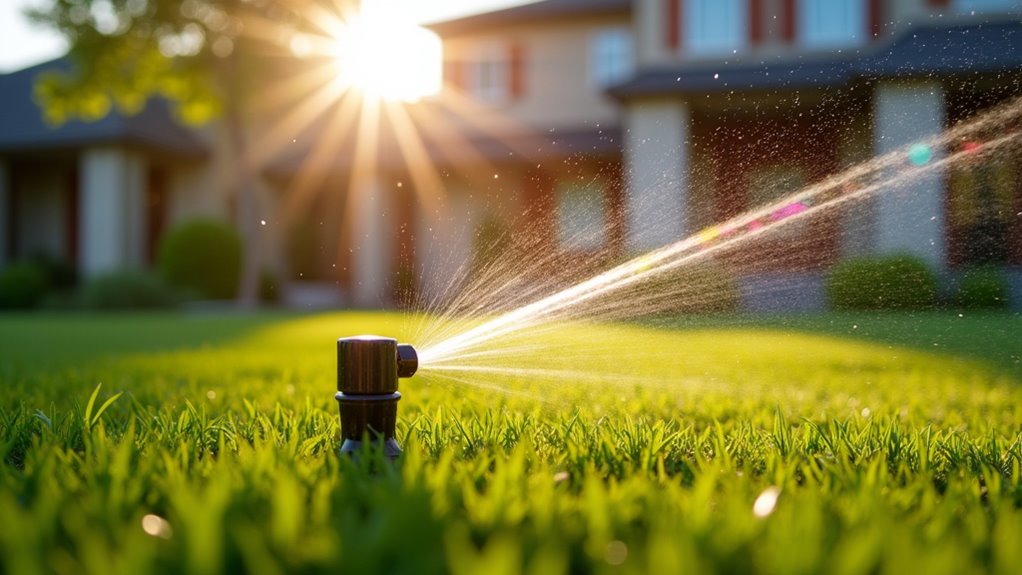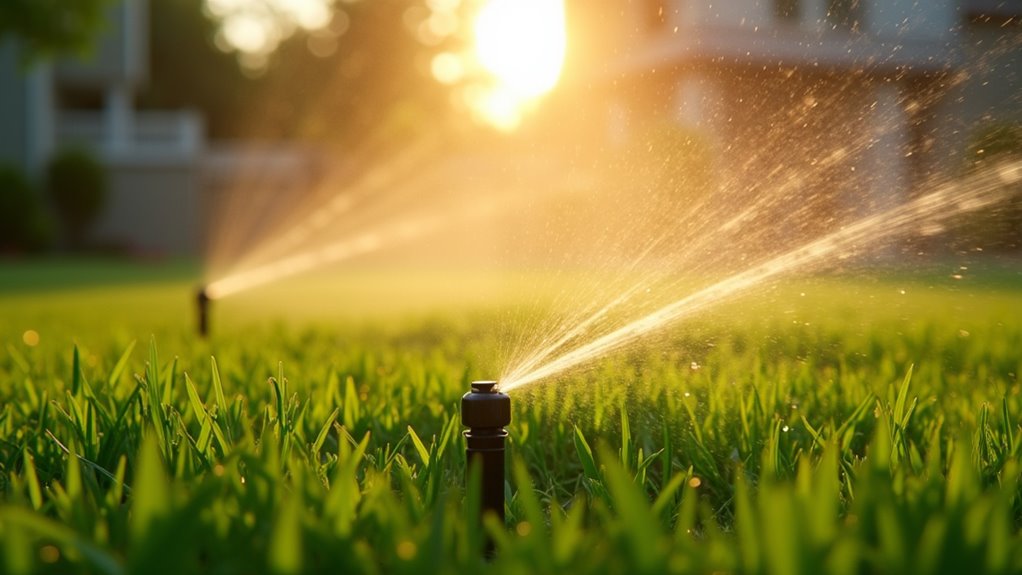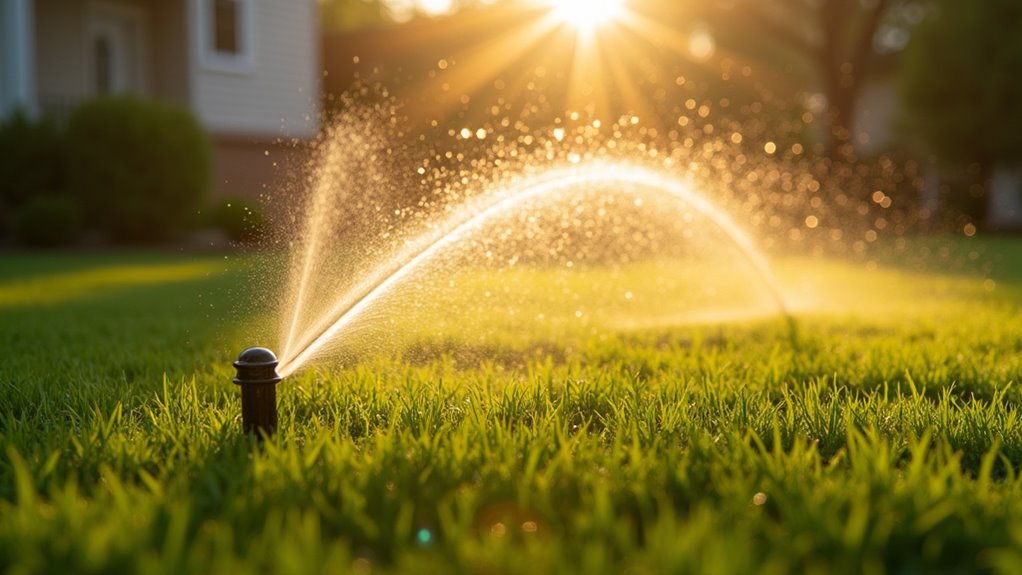Water your lawn thoroughly within the initial 24 hours after aeration, saturating the soil to a 4-6 inch depth. Apply water slowly to preserve aeration holes and establish deep root growth. Set your irrigation system to run 10-20 minutes each morning between 6-10 AM, maintaining consistent moisture without pooling. Monitor soil dampness daily using the tuna can method to achieve 1-2 inches of water weekly. Understanding proper post-aeration watering techniques will determine your lawn’s long-term recovery success.
The Critical First 24 Hours Post-Aeration
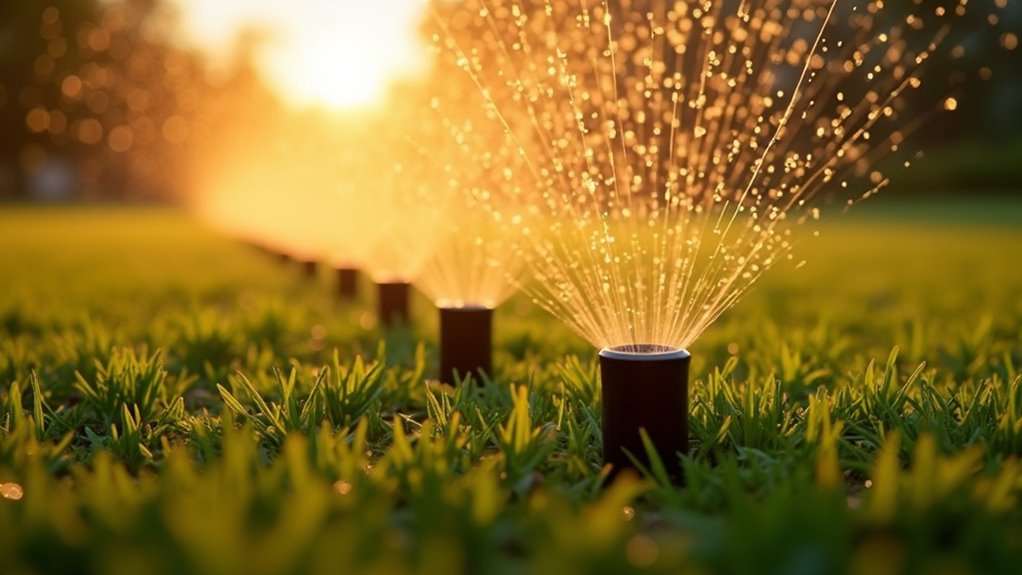
Once you’ve completed the aeration process, the next 24 hours are indispensable for maximizing the treatment’s effectiveness. You’ll need to water your lawn thoroughly, ensuring the soil becomes saturated to a depth of 4-6 inches. This deep penetration is imperative for excellent results.
Apply water slowly and methodically to preserve the integrity of the newly created aeration holes. You don’t want to disturb these openings, as they’re essential pathways for water, nutrients, and oxygen to reach the root zone. Focus on achieving deep soil saturation rather than surface-level moisture.
The initial post-aeration watering sets the foundation for successful lawn renovation, particularly if you’re planning to overseed. By properly hydrating the soil during this critical window, you’re creating ideal conditions for both existing grass recovery and new growth development.
Establishing a 4-Week Watering Schedule
You’ll need to maintain consistent moisture in your newly seeded lawn by watering each zone for 10-20 minutes every morning during the critical 28-day germination period. Your specific watering duration should be adjusted based on your soil type and the results of a simple “tuna can test” to measure water dispersal rates. To guarantee successful seed germination and strong root development, you must keep the seedbed consistently damp without creating pooling or runoff conditions.
Initial Moisture Requirements
Maintaining proper moisture levels during the initial 28 days after aeration is absolutely vital for successful seed germination. You’ll need to Water After Aeration with precision to ensure ideal results, allowing water to penetrate several inches into the soil without drowning the seeds.
Follow these essential moisture guidelines:
- Water your lawn for 10-20 minutes per zone each morning
- Keep the soil moist but not waterlogged during the entire 28-day period
- Begin watering immediately after the aeration service
- Apply enough water to dampen the first few inches of soil
- Monitor moisture levels daily to prevent excessive evaporation
The initial four weeks are paramount for seed development, so you’ll need to maintain consistent moisture through proper irrigation. This careful attention to watering will greatly impact whether your new grass establishes successfully or fails to thrive.
Adjusting Water Application Times
Successfully maneuvering through the critical post-aeration period requires a precisely structured watering schedule that transforms over four distinct weeks.
During the preliminary two weeks after aeration, you’ll need to water your lawn daily for 10-20 minutes per zone each morning. This consistent moisture is indispensable for seed germination and initial root development. As you transition into weeks three and four, reduce your watering frequency to 3-4 times weekly, allowing the grass to establish deeper roots.
After the fourth week, you’ll shift to a maintenance schedule of 2-3 waterings per week, delivering 1-2 inches of total water. If you’re working with sandy soil, stick to the higher end of these recommendations. Remember to water during morning hours when temperatures are cooler, maximizing absorption and minimizing evaporation for ideal lawn establishment.
Best Times of Day for Watering Success

You’ll achieve ideal results by watering your newly aerated lawn between 6-10 AM when cooler temperatures diminish evaporation and enhance soil absorption. Watering during mid-day hours (10 AM – 6 PM) wastes up to 30% of water through evaporation, reducing the effectiveness of post-aeration hydration. Evening watering sessions create prolonged moisture conditions that promote harmful fungal growth, so you should strictly avoid watering after sunset to protect your lawn’s health.
Morning Waters Prevent Evaporation
Timing your post-aeration watering sessions for early morning provides ideal moisture absorption while minimizing water waste through evaporation. Your grass and new seed need consistent moisture during the critical initial 4 weeks after aeration, making proper watering technique essential for success.
- Water each zone for 10-20 minutes during cooler morning hours
- Your new seed requires optimal moisture absorption before midday heat
- Morning watering prevents fungal diseases that develop overnight
- You’ll reduce water waste through evaporation compared to afternoon watering
- Early watering gives grass roots maximum time to absorb moisture
Mid-Day Watering Wastes Water
Mid-day watering sets up your lawn for significant water waste, with up to 30% of moisture lost to evaporation during peak heat hours between 10 AM and 2 PM. You’ll use much water unnecessarily during these hours, as the intense sun and higher temperatures prevent proper absorption into the soil and root system.
The best time to water your lawn is before 10 AM or after 6 PM when temperatures are cooler. Early morning irrigation is particularly effective, as it gives your grass time to absorb moisture before the day heats up. If you’re watering each day after aeration, you’ll want to be sure not to overwater during these ideal windows. Program your irrigation system to run in the early morning hours to enhance water efficiency and promote healthy grass development while using less water in general.
Evening Creates Fungal Risk
While evening hours might seem convenient for lawn irrigation after aeration, watering during this time creates dangerous conditions for fungal growth and disease development. As a lawn care professional, I strongly advise against evening watering after aeration, when your lawn’s watering needs are still vital but timing is imperative.
- Extended moisture exposure overnight promotes harmful fungal diseases
- Water droplets sitting on grass blades for 10+ hours create ideal conditions for fungus
- Limiting foot traffic becomes more difficult when grass is wet from evening watering
- Soil remains saturated too long without daytime evaporation
- Standing water in aeration holes overnight can lead to root problems
Always schedule your post-aeration watering between 6-10 AM to allow proper absorption while giving your lawn time to dry before nightfall. This timing optimizes the benefits of aeration while protecting your turf’s health.
Measuring Water Depth With the Tuna Can Method
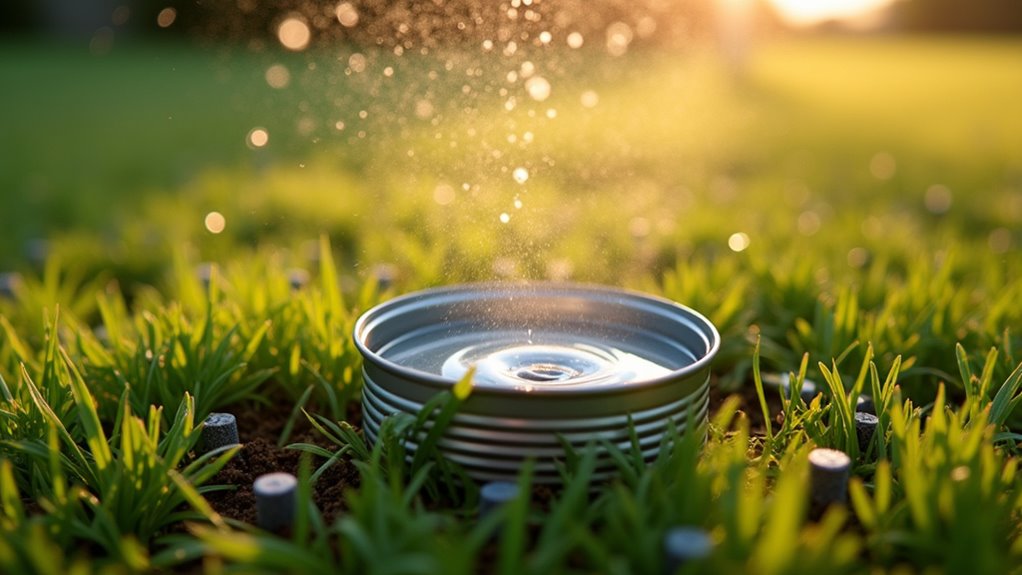
The tuna can method stands out as a precise, practical technique for measuring your lawn’s water intake after aeration. You’ll need to strategically place empty tuna cans throughout your irrigation zone to accurately gauge the amount of water reaching your Soil Plugs. This method helps you determine if you’re meeting the target of 1-2 inches of weekly water application.
| Water Depth | Irrigation Time | Action Needed |
|---|---|---|
| < 1 inch | 15 minutes | Increase time |
| 1-2 inches | 30 minutes | Maintain time |
| > 2 inches | 45 minutes | Reduce time |
Signs of Over and Under Watering
Monitoring your lawn after aeration requires more than just measuring water volume—you’ll need to recognize specific indicators of improper watering. After aeration and overseeding, your lawn’s watering needs become particularly important for successful seed germination and root development.
Watch for these essential signs to adjust your watering routine:
- Visible footprints remaining on grass indicate you should water more
- Folding or wilting leaf blades during daytime suggest insufficient moisture
- Yellowing or brown patches signal it’s time to increase watering
- Fungal growth or excessive weed development points to overwatering
- Shallow root systems develop when you’re watering too frequently
Your type of soil will influence how quickly these signs appear. If you notice any of these indicators, adjust your watering schedule immediately to maintain ideal moisture levels.
Adapting Water Needs Based on Soil Type
Understanding your soil type is critical for determining precise watering requirements after lawn aeration. If you’ve got sandy soil, your lawn requires more frequent watering cycles due to its rapid drainage characteristics. After core aeration, you’ll need to water these areas more often to maintain adequate moisture levels.
Make sure you’re adapting your lawn’s watering needs based on your specific soil composition. For loamy soils, establish a watering schedule of every 2-3 days to support exceptional seed growth. If you’re dealing with compacted soil, focus on longer, deeper watering sessions to guarantee proper penetration throughout the soil profile. Use a soil moisture meter or trowel to regularly check moisture levels at diverse depths. This testing helps you fine-tune your watering schedule and maintain ideal conditions for your newly aerated lawn.
Long-Term Maintenance After Root Establishment
Once your grass has established strong roots, maintaining proper watering practices becomes crucial for long-term lawn health. The goal is to keep your lawn hydrated with 1 inch of water per week, which is relatively easy to manage compared to initial establishment care.
Proper watering maintains lawn health after root establishment, requiring just 1 inch weekly – far simpler than initial care needs.
Your lawn’s watering needs will remain consistent year after year, requiring attention to these key maintenance points:
- Supply 1 inch of water weekly, adjusting for rainfall
- Perform annual aeration and overseeding to promote continued growth
- Follow proper watering guidelines after each yearly aeration service
- Monitor your lawn’s health for signs of drought stress
- Maintain consistent irrigation schedules throughout growing seasons
Seasonal Adjustments to Your Watering Routine
As the seasons shift throughout the year, your lawn’s water requirements fluctuate markedly based on temperature, precipitation, and growth patterns. You’ll need to adapt your watering routine, especially after aeration and overseeding, to guarantee your new grass seed establishes properly.
During hot summer months, increase both frequency and duration of watering to help roots penetrate the soil deeply. Your new lawn needs 1-2 inches of water weekly to combat drought stress. However, in spring and fall, reduce watering sessions as natural rainfall and cooler temperatures provide supplementary moisture. Monitor your lawn’s watering needs by checking soil moisture regularly – insert a screwdriver into the ground; if it enters easily, there’s adequate moisture. These seasonal modifications will help maintain prime growing conditions and prevent both over-and under-watering throughout the year.
Frequently Asked Questions
How Soon After Aeration Should I Water?
You’ll want to water your lawn immediately after aeration this is the perfect time frame for optimal lawn recovery. Don’t delay, as appropriate moisture levels are imperative in these initial hours. Start watering right away to help soil plugs break down and guarantee seed-to-soil contact. You should maintain frequent watering for 2-3 weeks, applying 1-2 inches of water during each session. The advantages of watering promptly include quicker turf healing and improved nutrient absorption.
What to Do to Your Lawn After Aerating?
After aerating, you’ll need to follow a strategic lawn care plan. Start by overseeding to fill bare spots, then establish a fertilizing schedule that provides balanced nutrients through the aeration holes. Monitor your mowing frequency don’t cut until new grass reaches proper height. Focus on thatch removal if it’s excessive, and consider soil pH adjustment based on testing results. Keep foot traffic minimal and consistently check for weed growth during this recovery period.
Is 30 Minutes Long Enough to Water Grass?
No, 30 minutes isn’t long enough to achieve adequate moisture levels for your grass. You’ll need 45-60 minutes per zone to guarantee proper soil penetration. Your watering schedule adjustments should account for drainage concerns, soil compaction reduction, and thatch layer impacts. Check your soil’s moisture depth by inserting a screwdriver – it should easily penetrate 1-2 inches deep. If you’re experiencing resistance, you’ll need to extend your watering duration.
Should You Fill Holes After Aeration?
You shouldn’t fill aeration holes, as they’re essential for reducing soil compaction levels and promoting better root development. Instead, focus on proper lawn topdressing requirements by applying a thin layer of compost or quality topsoil, which will naturally incorporate into the holes while providing nutrients. For ideal results, combine thatch removal necessity with immediate seed application timing. This approach allows for effective soil amendment incorporation while maintaining the benefits of aeration.

